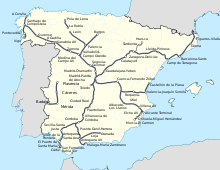Renfe Class 730
| Renfe Class 730 Talgo 250 | |
|---|---|
passenger cars[1] | |
| Multiple working | Yes |
| Track gauge | 1,435 mm (4 ft 8+1⁄2 in) / 1,668 mm (5 ft 5+21⁄32 in)[1] |
The Renfe Class 730 or S-730
Background and design
The trainsets are designed for high-speed services on conventional
The trainset consists of 13 cars, including 2 electric power cars, 2 diesel-generator cars and 9 passenger coaches between them. The power cars are technically special single-sided electric locomotives and do not have seats for passengers, nor do the diesel generator cars coupled behind them instead of the end passenger coaches of the Class 130 series trains. Diesel generator cars and passenger coaches have an articulated connection with common bogies. Passenger coaches including 6 second class coaches, 2 first class coaches and 1 bistro coach for restaurant/sales services. Capacity in standard class is 36 seated, in first class — 26 seats in one coach and 22 seats in another coach, which also has a single place for disabled people.[1]
The power cars use AC traction motors controlled by
2013 Santiago de Compostela accident
On 24 July 2013 a Renfe Class S730[12] running as the Alvia 4155 service from Madrid to Ferrol derailed and crashed near Santiago de Compostela in north-western Spain, killing 79, out of 218 passengers on board. The cause of the accident is not yet officially determined, but the train was alleged to be traveling over twice the posted speed limit while entering a curve, due to the absence of ERTMS.[13]
See also
- Renfe Class 130
- List of high-speed trains
- Stamps with Renfe Class 730 Archived 2016-03-04 at the Wayback Machine
References
- ^ a b c d e f g h i j k l m n o p "Talgo 250" (PDF). 2016-03-04. Archived from the original (PDF) on 23 November 2015.
- ^ Bombardier Transportation in Germany p. 14, Bombardier.com
- ^ a b "Talgo 250 Dual". talgo.com.
- ^ a b "Talgo Series VII Passenger Coaches". 2010-03-28. Archived from the original on 28 March 2010.
- ^ From Serie 730 de Renfe
- ^ Trayectos y Servicios - clase preferente Renfe.es
- ^ Trayectos y Servicios - clase turista Renfe.es
- ^ [1] [permanent dead link]
- ^ [2] [permanent dead link]
- ^ "The Talgo Pendular Coaches" (PDF). 2011-07-16. Archived from the original (PDF) on 16 July 2011.
- ^ "POWER HEAD TALGO 250" (PDF). 2011-07-16. p. 7. Archived from the original (PDF) on 16 July 2011.
- ^ "train-crash-2-1-402x293.png (402x293 pixels)". Archived from the original on 24 July 2013. Retrieved 30 May 2022.
- ^ Rodrigo Silva; Antonio Alonso (25 July 2013). "Accidente ferroviario en Santiago de Compostela". El País (in Spanish). Madrid. Retrieved 25 July 2013.
Other sources
External links
- Renfe Serie 130 Information from Ferropedia.es

